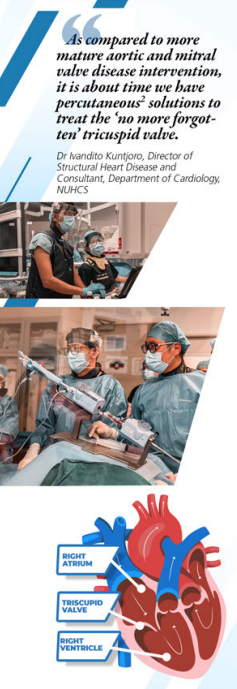The Forgotten Heart Valve
Novel solutions to treat leaky tricuspid valve
PULSE Issue 40 | January 2023
On 2 Sep 2022, the National University Heart Centre, Singapore (NUHCS) performed its first Transcatheter Edge-to-Edge Repair (TEER) for the tricuspid valve, one of the heart's four major valves.

TEER is a minimally invasive procedure that treats 'leakage' (also known as regurgitation) of the tricuspid valve without requiring open-heart surgery.
The procedure is performed by placing the clips on tricuspid valve to reduce the severity of regurgitation. The clips are delivered through a small incision on the right groin to access the femoral vein. By using the guidance from advanced live 3D imaging, the clip of roughly 2cm in open-position length was placed precisely on the desired part of the leaky valve, and the procedure is performed on the beating heart. After the procedure is completed, patients can return to their regular daily activities within a week or two.
One of the most common valvular abnormalities, Tricuspid Regurgitation (TR) occurs when the tricuspid valve does not close properly, resulting in the back flow of the blood from the lower right chamber (ventricle) to the upper right chamber (atrium) of the heart. The pressure in the heart then increases as there is a substantial strain from the back flow of blood, which can cause leg swelling, shortness of breath, excessive fatigue, and eventually lead to heart failure.
TR is commonly diagnosed in older people and especially in patients more than 75 years of age. With our aging population and increased complexity of cardiac conditions, there will be a growing need for less invasive valvular heart disease treatment like TEER. Before the introduction of this percutaneous treatment for severe TR, elderly patients who are considered high-risk for surgery had very limited treatment options without significant improvement of their medical symptoms.
However, novel Transcatheter Tricuspid Valve Interventions (TTVIs) such as tricuspid valve replacement and leaflet coaptation repair have shown to have safer and better long-term results compared to only treating with medications. Further, newly published research data debunked traditional thinking that patients with pacemakers may not be eligible for or respond to tricuspid TEER therapy. Even patients with pacemakers will now have access to less invasive percutaneous treatment for severe TR.
What was once a "forgotten: valve with limited treatment options is now receiving exciting updates for percutaneous valve intervention -- providing a less invasive treatment option and a faster recovery process for patients.
